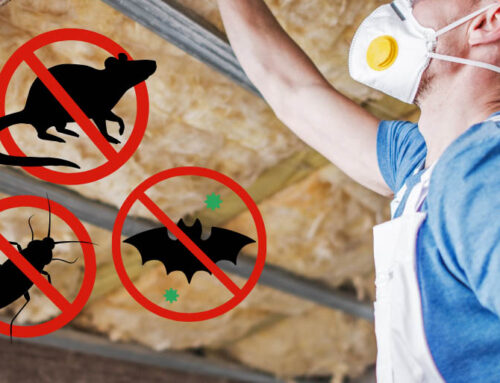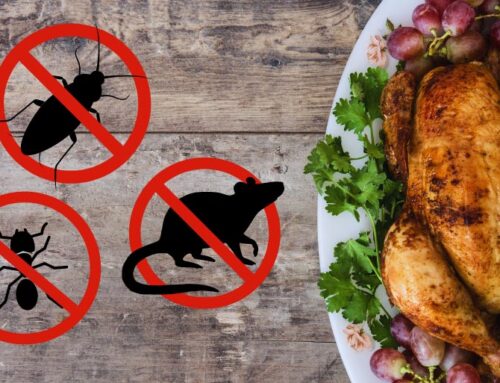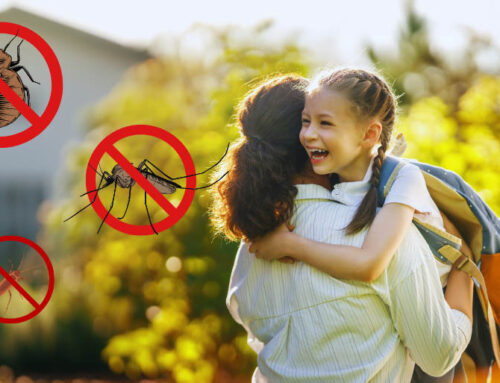As Halloween draws near, your eerie decorations might attract more than just curious trick-or-treaters. Real pests like spiders, stink bugs, and rodents can invade your festive setup, turning your spooky display into a real horror show.
Whether it’s webs on your fake cobwebs or critters inside your pumpkins, effective Halloween pest control is key to enjoying a truly fright-free holiday.
Here’s how you can protect your decor and keep the creepy crawlies out this season.
Common Halloween Pests to Watch Out For
Before we dive into the Halloween pest control tips, let’s first identify the most common Halloween bugs and other creepy crawlers you might encounter in your home this spooky season.
These pests are notorious for sneaking into your Halloween decor, so it’s essential to know what to look for.
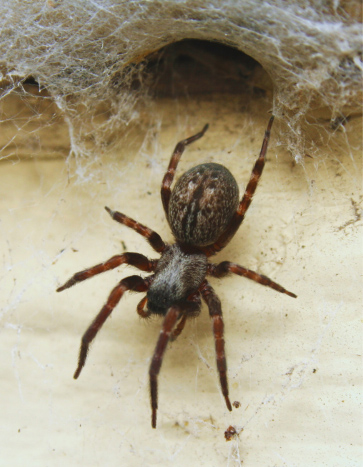
Spooky Spiders
Spiders are a Halloween icon, but real ones aren’t as fun. In Iowa, the common house spider often finds its way indoors as temperatures drop, seeking refuge in your Halloween decor.
Their tangled webs in dark corners or amongst your decorations can surprise you, adding a creepy touch to your spooky scene.
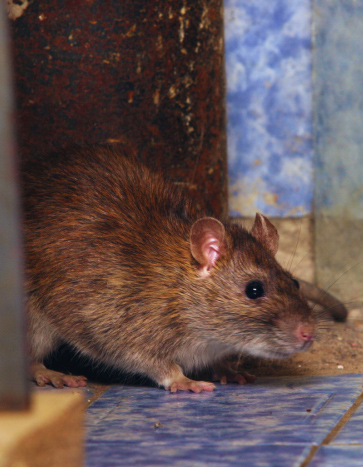
Hairy Rats
Rats in Iowa, particularly the Norway rat, seek warm spaces as fall arrives. Your Halloween setup, especially in attics or basements, might become their next hiding spot.
These rats are notorious for gnawing through wood and wires, causing damage and spreading diseases—turning your decorations into an unwanted scare.
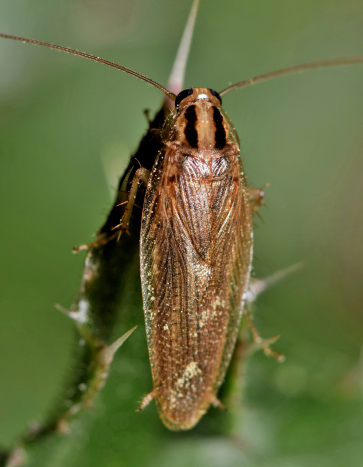
Creepy Cockroaches
In Iowa, the German cockroach is a master at hiding in dark, damp areas like your Halloween decor. These pests often find their way into forgotten boxes or beneath pumpkins.
Beyond their creepy appearance, German cockroaches can spread bacteria and allergens, making them a serious concern for homeowners.
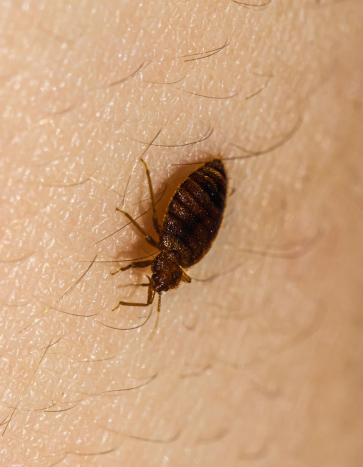
Blood-Sucking Bed Bugs
Bed bugs are a nightmare, especially around Halloween. These tiny, blood-sucking pests are common in Iowa, often hitching a ride on clothing or furniture.
While they prefer beds, they can also hide in Halloween decorations. Their bites are irritating and can quickly turn your spooky fun into an itchy, uncomfortable experience.
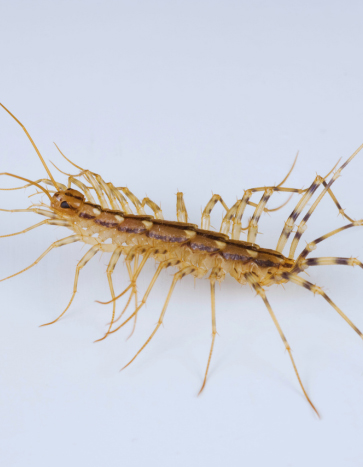
Crawly Centipedes
Centipedes might not top your list of Halloween pests, but in Iowa, they’re frequent visitors. These fast-moving, multi-legged critters love dark, damp areas, making your Halloween decor a prime hiding spot.
While centipedes aren’t dangerous, their sudden appearance can certainly add an extra scare to your Halloween setup.
Understanding the types of pests that might invade your Halloween decorations is the first step in keeping your home festive and fright-free.
By recognizing these creepy crawlers, you can take proactive measures to protect your decor and ensure that the only scares this Halloween come from your spooky setup—not uninvited pests.
Why Pests are Attracted to Halloween Decorations
Now that we’ve identified the most common Halloween pests, it’s important to understand why these critters are drawn to your festive displays. Knowing what attracts them can help you better protect your home from unwanted infestations.
The Appeal of Pumpkins and Gourds
Pumpkins and gourds are iconic Halloween decorations, but they’re also irresistible to many pests, particularly Halloween bugs. Here’s why:
Dark Corners and Hidden Spaces
Halloween decorations often create dark, secluded spaces that are ideal for pests. Consider these points:
How Halloween Decorations Mimic Natural Habitats
Many Halloween decorations unintentionally mimic natural habitats, attracting pests looking for familiar surroundings:
While Halloween decorations bring festive joy, they can also unknowingly invite pests into your home. By understanding what draws these critters to your decor, you’re better equipped to anticipate and mitigate potential infestations.
With this knowledge, you can keep your Halloween setup both spooky and secure, ensuring a fun and pest-free celebration.
Quick Tips for Halloween Pest Control
Knowing which Halloween bugs and pests are drawn to your decor is just the beginning. Now, it’s time to take action with effective pest control measures. Use these quick tips to protect your festive displays and keep your Halloween decor pest-free.
Use Pest-Repellent Decorations
Start your pest control efforts by choosing decorations that actively deter unwanted critters. Here’s how:
Proper Storage and Handling of Pumpkins
Proper storage and handling of pumpkins can help you control and reduce the risk of pest infestations. Follow these steps:
Regular Cleaning and Maintenance of Decor
Active cleaning and maintenance are key to controlling pests around your Halloween decorations. Here’s what to do:
Pairing these easy pest control tips keeps your Halloween decor safe from unwanted pests. By taking action now, you can enjoy a worry-free, festive season, knowing your decorations are well-protected.
Long-Term Pest Prevention Strategies
While quick fixes can help keep pests at bay during Halloween, long-term strategies are key to preventing infestations year-round. Here’s how you can protect your home beyond the spooky season.
Sealing Entry Points
Pests often enter homes through small gaps and cracks that are easy to overlook. Sealing these entry points is essential for long-term prevention. Focus on these areas:
Professional Pest Control Options
For a more comprehensive approach, professional pest control services provide tailored, long-term solutions. Here’s what they can offer:
Implementing these long-term strategies ensures your home stays protected from pests well beyond the Halloween season.
By sealing potential entry points and considering professional pest control options, you can create a secure, pest-free environment that lasts all year round.
What to Do If Pests Invade Your Halloween Decorations
Even with the best prevention strategies, pests can sometimes find their way into your Halloween decor. Here’s how to handle the situation effectively, from identifying the problem to deciding when it’s time to call in the professionals.
Identifying the Infestation
The first step in managing a pest problem is recognizing that it exists. Look for these signs:
Safe Removal and Cleanup
Once you’ve identified an infestation, follow these steps for safe removal and cleanup:
When to Call a Professional
If the infestation is severe or challenging to manage, it’s time to consider professional help. Here’s when to call in the experts:
Dealing with pests in your Halloween decorations can be a hassle, but by quickly identifying the issue and taking appropriate action, you can minimize the damage and restore your festive spirit.
And remember, when in doubt, professional help is just a call away, ensuring your home remains pest-free and ready for the holiday fun.
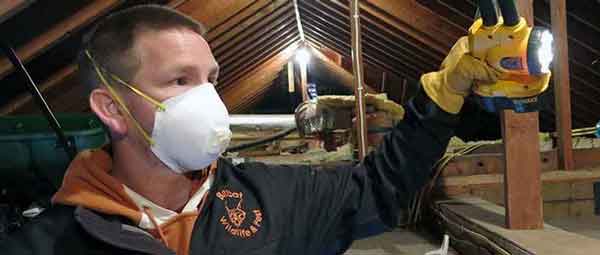
About the Author
Gene Spaulding, Owner and Founder of Bobcat Wildlife & Pest Management, has been at the forefront of pest and wildlife control since 2008. With over 17 years of hands-on experience, Gene combines his expertise and passion to deliver effective and humane pest management solutions to homeowners and businesses across the Des Moines Metro area. Guided by the motto “Your Property, Our Priority,” Gene ensures that Bobcat Wildlife & Pest Management remains a trusted partner for comprehensive pest and wildlife services.

